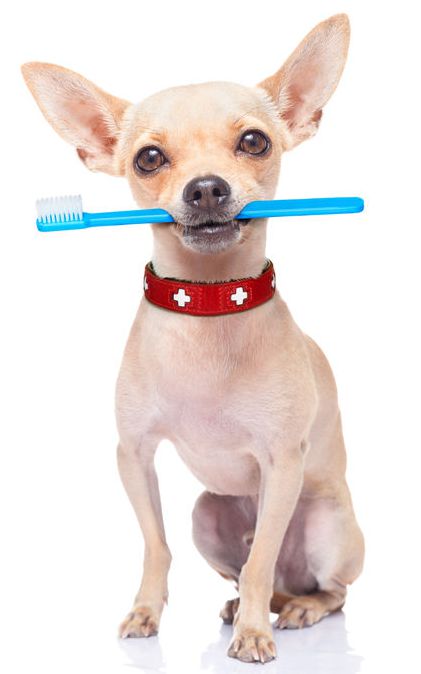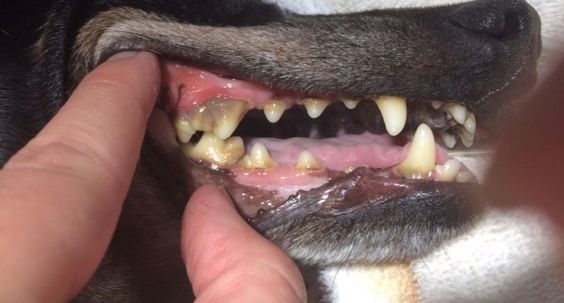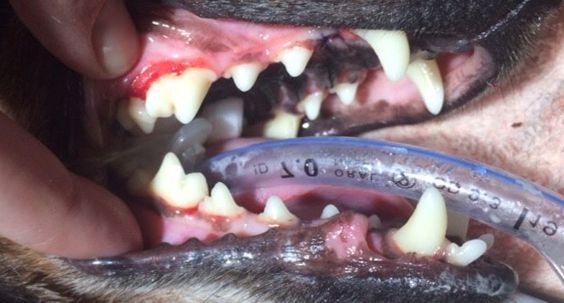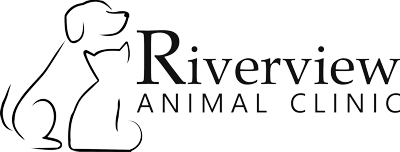 Just like in people, routine dental care is important not only for health of the teeth and oral cavity, but for overall health of your pet. Dental disease can cause pain, inability to eat, and behavioral changes in your pet. Common signs that dental care is needed include bad breath, consistent drooling, brown or yellow build-up on the teeth, broken teeth, and red and/or bleeding gums. Cats may get red lesions not only on their gums, but also in other locations in the mouth. Diseased teeth can be a serious source of pain and discomfort.
Just like in people, routine dental care is important not only for health of the teeth and oral cavity, but for overall health of your pet. Dental disease can cause pain, inability to eat, and behavioral changes in your pet. Common signs that dental care is needed include bad breath, consistent drooling, brown or yellow build-up on the teeth, broken teeth, and red and/or bleeding gums. Cats may get red lesions not only on their gums, but also in other locations in the mouth. Diseased teeth can be a serious source of pain and discomfort.
The best way to prevent dental disease is to allow your veterinarian to assess your pet’s teeth yearly. At your pet’s annual exam your veterinarian can tell you if, or when, your pet needs a routine dental cleaning (see more info below). It is important to note that small dogs often need dental cleanings yearly. If cleanings are not done routinely your pet may develop diseased teeth that need to be extracted to prevent further pain and discomfort.
Our veterinarians love preventative medicine and would be happy to discuss ways to keep your pets mouth healthy throughout their life. Please set up an appointment today if you’re concerned about your pet’s oral health so we can work together to help keep your pet and their mouth healthy.

Before dental cleaning.
The brown on the teeth is plaque and tartar build up. Excessive plaque and tartar can lead to gum recession, infection, and decay of teeth.

After dental cleaning.
Teeth are free of plaque and tartar, the mouth is healthy, and the cleaning was done early enough no teeth extractions were needed.
Common Questions
A dental consists of a comprehensive oral health assessment and treatment (sometimes called a ‘COHAT’). Appropriate dental cleaning and other dental procedures require that the animal be under general anesthesia since animals won’t tolerate the procedures awake. Once under anesthesia, just like in human dentistry, your pet’s teeth are examined for evidence of disease or decay and this information is charted for future reference. Then the gum tissue around each tooth is probed to assess the health of the tissue and the underlying tooth roots. Next the entire oral cavity, including the tongue, throat, and cheeks, is thoroughly examined. Finally, the teeth are cleaned ultrasonically to remove the tarter; any diseased, loose or painful teeth are removed if necessary; the enamel is polished; and the mouth is rinsed of all debris so that your pet returns home with a clean, healthy mouth and fresh breath!
Routine, preventive cleaning is the best way to keep your pet healthy and a routine cleaning schedule should be discussed with your veterinarian. The frequency of cleaning cannot be determined without an exam since some pets need more frequent, and some less frequent, cleaning. Many small breed dogs are more prone to dental disease and require more frequent cleanings than other breeds of dogs. Large breed dogs tend to need less frequent cleanings. However, each patient is an individual and frequency of cleaning can only be determined by scheduling routine oral examinations. Cats oral health varies; the frequency of cleaning cannot be determined without an exam.
Our veterinarians would love to help keep your dog’s mouth healthy. Please call (509-758-5022) to schedule a dental evaluation and cleaning. The veterinarian will sit down with you and explain what will happen during and after your pet’s dental procedure. They will answer any questions you have and discuss whether they are concerned there may be extractions done during the dental.
Routine cleaning may cause some discomfort but is unlikely to be truly painful. However, because animals don’t understand that uncomfortable procedures may be performed to improve their health, veterinary dentistry is done under general anesthesia, which will decrease any discomfort that your pet may experience. To further decrease any discomfort that might occur during the dental procedure, at Riverview Animal Clinic we use pain relieving drugs and local blocks (the same blocks that dentists that work on people use) to help keep your pet comfortable during and after the procedure.
Yes! Older pets, like older people, may suffer a greater negative impact from disease than younger pets. Any disease, including dental disease, can negatively affect the overall health of your geriatric pet. Dentistry is necessary in old pets with dental disease!
Prior to anesthetizing your pet for dentistry, we will do a thorough physical exam, complete blood work analysis, as well as other tests if deemed necessary by your veterinarian. All of this is done to make sure that your pet is healthy enough for anesthesia. In addition, we utilize the latest in anesthesia drugs, monitoring of vital functions, support of physiological processes (like blood pressure) and pain control to minimize risks.
- Thorough oral health exams
- Ultrasonic cleaning and polishing
- Removal of gingival hyperplasia
- Extractions of diseased, broken or unhealthy teeth – these can be really painful to your pet!
- Removal of deciduous (or ‘baby’) teeth – retained baby teeth can hinder the growth of permanent teeth or cause crowding with tarter buildup on healthy teeth.
- And other dental procedures as recommended by our doctors
We offer guidance for brushing teeth and supplies, such as toothpaste and brushes. Brushing teeth and using products that improve the oral health of your pet can extend the time between dental assessments and help your pet have the best breath possible.
There is a complete list of veterinary-approved chew toys at this website: Veterinary Oral Council at http://www.vohc.org
For more information on veterinary dentistry, contact us at Riverview Animal Clinic (509-758-5022), or visit the American College of Veterinary Dentistry at http://www.avdc.org/ownersinfo.html or the Veterinary Oral Council at http://www.vohc.org
